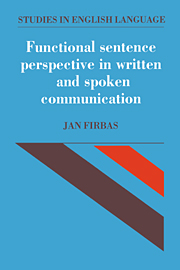Book contents
- Frontmatter
- Contents
- Preface
- List of abbreviations
- Part I Functional sentence perspective in written communication
- Part II Functional sentence perspective in spoken communication
- 8 Non-prosodic distribution of degrees of communicative dynamism and degrees of prosodic prominence
- 9 Some more observations on the relationship between the non-prosodic distribution of communicative dynamism and that of prosodic prominence
- 10 Analyses of two spoken texts
- 11 Some special issues concerning functional sentence perspective in the spoken language
- References
- Index
10 - Analyses of two spoken texts
Published online by Cambridge University Press: 19 November 2009
- Frontmatter
- Contents
- Preface
- List of abbreviations
- Part I Functional sentence perspective in written communication
- Part II Functional sentence perspective in spoken communication
- 8 Non-prosodic distribution of degrees of communicative dynamism and degrees of prosodic prominence
- 9 Some more observations on the relationship between the non-prosodic distribution of communicative dynamism and that of prosodic prominence
- 10 Analyses of two spoken texts
- 11 Some special issues concerning functional sentence perspective in the spoken language
- References
- Index
Summary
In this chapter I will analyse two spoken texts extracted from longer conversations. The first is taken from Arnold and Tooley (1972) and the second from the Corpus. The analyses will also include some statistics. Special attention will be paid to the frequencies of the types of relationship between the non-prosodic CD distribution and the PP distribution.
In the diagnoses concerning the relation between the two distributions, the following new abbreviations are introduced: PERF (perfect) CORR (correspondence), N-R (non-reevaluating) INT (intensification), R (re-evaluating) INT (intensification), and DESH (deshading). The abbreviation N-R INT always denotes the selective type of non-reevaluating prosodic intensification (see p. 159).
In each case the abbreviation is followed by one of the following symbols: o (indicating absence of post-IC prosodic shade); 1 (indicating the presence of a post-IC prosodic shade made up of one or more context-dependent communicative units); 2 (indicating the presence of a post-IC prosodic shade made up of one or more context-independent communicative units occurring in the shade on account of their semantic character); 3 (indicating the presence of a post-IC prosodic shade produced by re-evaluating prosodic intensification); 1 + 2 (indicating the presence of a post-IC prosodic shade made up of one or more communicative units of type 1 and one or more communicative units of type 2); 0.2 (indicating the presence of a post-IC prosodic shade that arises within a communicative unit that provides a distributional subfield and stands last within the basic distributional field; the shaded units are of type 2).
- Type
- Chapter
- Information
- Publisher: Cambridge University PressPrint publication year: 1992

